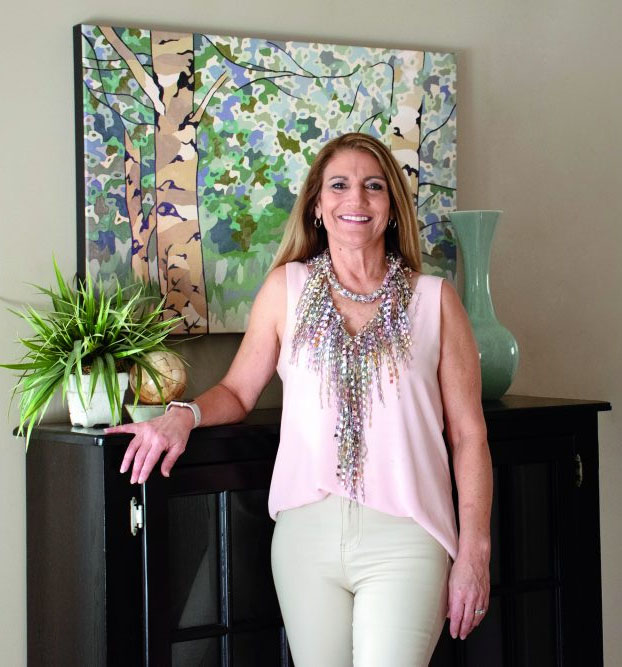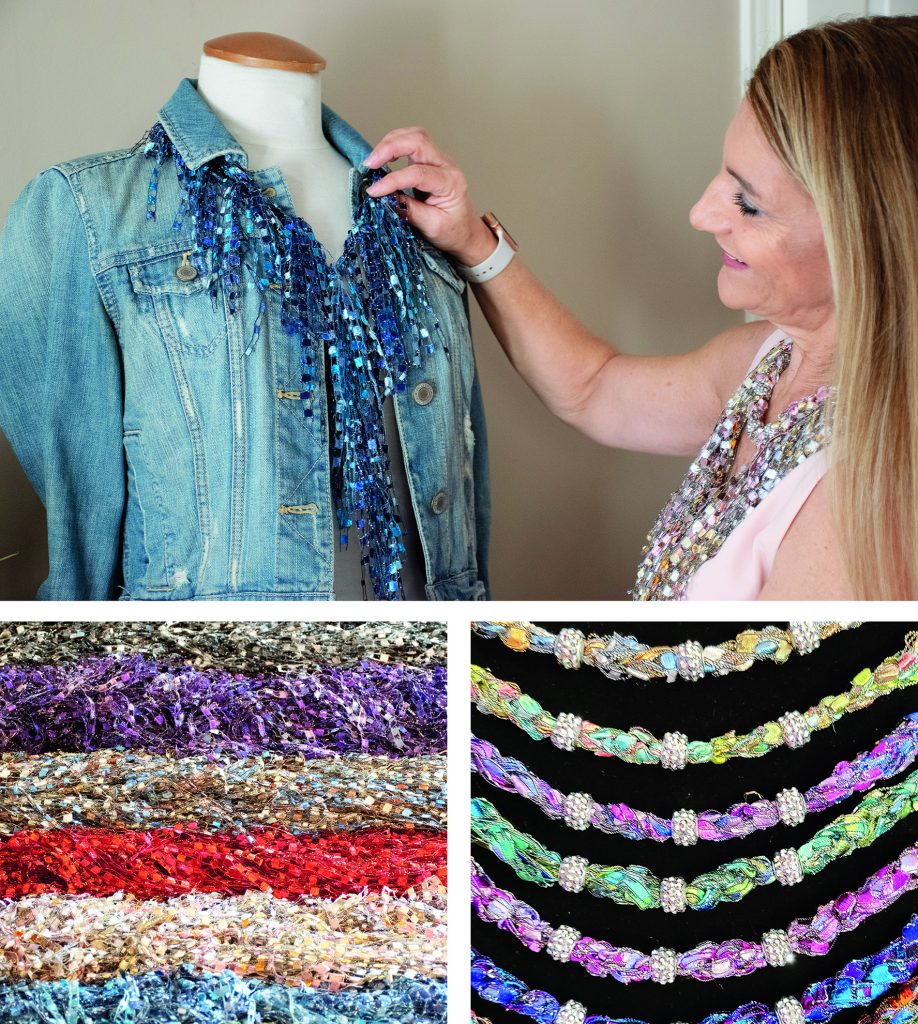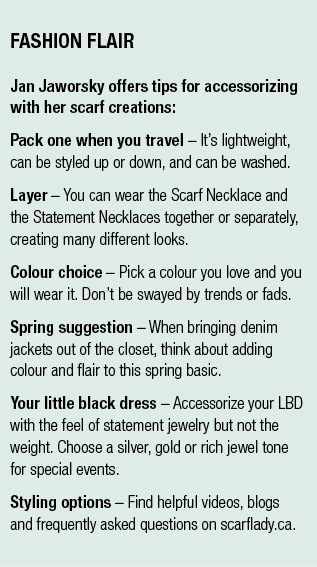 By Lynn Haddrall
By Lynn Haddrall
Jan Jaworsky launched her fashion career in an unstylish place. Kind of a barn, really. Like other hockey moms, Jaworsky spent a lot of time in arenas, watching her sons, Michael and Christopher, play for the Waterloo Wolves. In downtime or when games were too intense, she distracted herself by knitting scarves. After hauling bags of material to one arena after another, she became known as the scarf lady.
Her scarves became popular with hockey parents; she even made some in Kitchener Ranger colours. Soon she was selling her creations to raise money for the Waterloo team. “It quickly evolved, and I moved into more fashion-type scarves that expanded well beyond just the Waterloo Wolves hockey team colours,” Jaworsky recalls.
“I just kept seeing the desires of the women and what they were looking for. And it became clear that they wanted to wear them beyond the fall and winter season.” Jaworsky focused on challenges some women associate with wearing a scarf or a statement necklace. “With a scarf, you might get too hot. Then there’s other women who love the statement jewelry, but maybe after a long day, it’s heavy around their neck or they have sensitivities. “I saw this real need for a really lightweight state, a stunning statement piece for women who traditionally like the fashion scarves or like the statement jewelry, but not the bulk or the weight around their neck,” Jaworsky says. She researched yarns suitable for a hybrid scarf/necklace, aiming for an accessory she describes as “art you can wear.” Metallic and non-metallic yarns are mixed in a variety of colour palettes. The finished product is lightweight. It looks delicate, but Jaworsky is happy to stretch and pull it to demonstrate its strength. It can also be washed. “Growing up, I was always a maker. Maybe I was making a project at the cottage helping my dad build little projects. And then I got into sewing and handiwork,” she says. “I always had this little component where if I wasn’t doing school or work, it was my pastime.” Later in life, her mother-in-law also stoked Jaworsky’s creative fire by encouraging her to crochet.
But before Jaworsky started her accessories business, she worked in the technology industry for many years. Her parents, both educators, encouraged her to focus on math. This led her to the University of Waterloo for a math and business degree. She met her husband there and they pursued careers in the tech sector. Jaworsky began her tech career with IBM on several co-op terms in Toronto and London. She went on to work for a start-up company called Watcom which became Sybase where she worked for more than 20 years. In her senior roles there, she managed large budgets and attended trade shows to promote company products. After leaving the tech world, she was ready for new ventures. What began as a hobby became a business in 2012. Drawing on her arena nickname, Jaworsky created ScarfLady, attending craft shows near and far with her creations. Early on, she found similarities with those trade shows she attended as a tech executive.
“You would pop up your little booth as a start-up and you would market your wares. An interesting concept is that they’re makers of software, similar to the makers in the artisan community and I saw such parallels when I started doing shows, similarities between the artisans and the software makers,” Jaworsky says. “They love making their things, but they don’t always love selling them. They’re not that comfortable with that kind of thing. It was an interesting experience meeting these makers.” At her early craft shows Jaworsky had help from her husband, Dave Jaworsky, former mayor of Waterloo. He had left his job at BlackBerry and was familiar with sales through tech shows. It was an adrenaline rush for both of them. “We would go around and pop up our little booth, just like we did in the days of high tech, and market our wares.” She remembers it fondly. “Dave’s doing sales and my girlfriend is helping people pick colours and it was absolutely crazy busy and overwhelming and fun and all those things.” The first questions she was often asked at her booth were “What is it?” and “How do I wear it?” She showed how to style it with a single, double or triple loop to change the look. “And then they would be playing with it themselves and just be fascinated with the concept.” Jaworsky moved on to high-profile shows like the One of a Kind events in Toronto and Chicago where you must apply and be accepted as a vendor.

It was an amazing experience that allowed her to travel with other local vendors and get to know that creative community. “You learn from the other vendors who have been to Chicago because there are different kinds of things you need to know, similar to Toronto. Or if it’s Christkindl (in Kitchener), you learn from the vendors what to expect or what might be different. “It’s a real community; I’m still very close to a lot of the vendors. I would go to a show just to reconnect and see how they’re doing.” Shows were a chance for Jaworsky to chat with customers and build their feedback into future designs. As the business grew, she was able to mentor young people. “I worked with a lot of young people, especially kids playing sports. They couldn’t get jobs because they couldn’t commit to a schedule. So, a lot of them would help me and they could work on their own schedule,” Jankowski says. “I love the idea of them learning about running a business and what goes into making.”
Kayla Soosaar met Jaworsky at the hockey arena while watching her brother Bobby play. She started working with Jaworsky at trade shows and now helps create the accessories. She gets the patterns and colour choices from Jaworsky, then builds a basic piece to which Jaworsky adds final touches. Soosaar sees Jaworsky as a mentor who has taught her about running a small business and working in the creative field. “I feel like she’s given me lots of really good opportunities just to build skills. When I was selling at the craft shows, it helped me build confidence interacting with the public,” Soosaar says. “Now, it’s more melded into accountability and productivity and autonomy in a project, because I’m the one in charge of the productivity behind it.” Soosaar has a career as an assistant in occupational therapy but still works part time with Jaworsky. “It’s interesting how she created this product with her math brain. I’ve seen how she’s really made it into a formula and a process in a really clear way,” she says.

Jaworsky leaned on those business skills when the COVID-19 pandemic disrupted her craft shows. Customers migrated to her website (scarflady.ca) which she had previously used mostly to connect with current customers. “As time went on, I realized shows weren’t going to pop right back up again. I more seriously invested in that online platform to not just market to people who knew who I was, but to market to people who didn’t know who I was. And that’s where you meet a whole different group of new people.” Jaworsky is unsure if she will return to craft shows this year. It might be hard to juggle her growing online business. For now, she is busy preparing for the rush of gift orders that come for Mother’s Day plus Canada Day requests for red and white items. There are also new ideas to pursue and limited editions that Jaworsky uses to gauge demand for future products. When we met, she was developing lightweight dangle earrings that look beaded. This stylish entrepreneur launched her home-based business by melding two traditional accessories into one, just like she draws on elements of her tech career and her creative work. She often reflects on the parallels. “You go through all the same beta tests and the alpha tests and getting the materials and trying it out with internal testing and then an initial launch,” she says. “It’s the same concept. I love that.”
